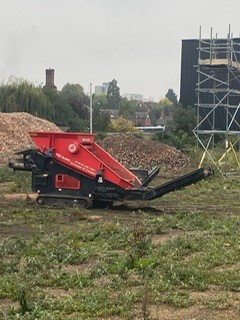Size covered: 7 m2
BACKGROUND
Knotweed Services (UK) Ltd were contacted by a property manager in Longbridge to organise a site survey to determine the size and risk of the Japanese Knotweed. Our client had warned us he was not aware of previous treatment or how long the infestation had been there.
SITE SURVEYS
At time of survey, there was a clear evidence of Japanese Knotweed at the property. Our client stated the JKW had been at the property for at least 5 years, which would have allowed the plant to establish a deep rhizome system. I suspected the rhizome to be as deep as the retaining wall. I thought it had probably spread laterally along the wall as there was Knotweed wherever there was substrate.
Due to the stands maturity, I said there may be vigorous growth when the growing season begins. There is already damage to the retaining wall so I suggested beginning remediation works immediately since the growing season was not far away. Growth in the year will cause further damage to the wall and it is possible that the wall could collapse.
I recommended firstly removing all the dead stems and burning them off site. The site should then be cleared of litter (glass especially) to allow works to be done safely. Crown removal and herbicide treatment was not an option for this site. The risk of the retaining wall collapsing was too high for any operatives to undertake such works. Due to the damage of the wall I said the only option would be to take down the wall and mechanically remove the Knotweed. I recommended removing the soil containing the Knotweed offsite using a grab wagon or alike. The wall would have to be rebuilt quickly after the soil has been removed and a membrane barrier installed.
I informed this would likely immediately resolve the Japanese Knotweed issue. A 2 year monitoring period is recommended following the works to insure no Knotweed regrowth occurs.
All staff at the garage and the tenant of property B was to be informed of the Knotweed and told how to prevent it spreading. Cooperation is key to any successful Knotweed remediation project. Therefore, with the clients permission I thought we should liaise with McDonalds to see if they are currently treating the Knotweed or if they have ever had any. At the very least I advised a letter should be presented to them explaining the presence of Knotweed and your planned remediation works.
Allowing the Knotweed to spread onto McDonalds land would cause legal issues, specifically related to encroachment. I informed if a management plan is to be taken out the client can be shown to have done everything in their power to prevent encroachment.
The plant is invasive and its growth is rapid. Such is the concern about the ability of this plant to grow on and under properties, that recent amendments in legislation has provided powers for the local authorities to investigate and where necessary, request steps are taken to control its growth and the Act provides the authority with the powers to serve a Community Protection Notice (CPN).
Our client was informed of this and a report/quotation was prepared.
MAPPING
The mapping stage of our plans is crucial to identify the location of the infestation. This not only helps to indicate the proximity to boundaries/habitable space & outbuildings and the associated RICS classification, but also identifying the possible migration (7m buffer zone).
See Site Map below:

TREATMENT
The rhizome extent was much larger than expected, it extended laterally beyond what was anticipated. The rhizome was exceptionally large as can been seen in images. This indicative of a very mature Japanese Knotweed stand.
Excavation works have revealed that a lot of the rhizome extends into the neighbouring property. I would estimate that approximately 60% of the rhizome is probably found on the neighbouring properties land. At the time of survey, lots of small growths were observed in the neighbouring property. I would speculate that the Japanese Knotweed is being regularly treated on the neighbouring property since no old canes or litter can been seen on that side.
Prior to the start of these works, it was identified that the new wall had been structurally damaged (we are of the opinion that a car had reversed into it) and found that the end of the wall and return had become very loose. We reinstated the wall before the commencement of our works.
The site was successfully cleared of dead canes and rhizomes were removed where access was available.
The area was treated with herbicide using a handheld knapsack sprayer and the backfilled area was prepped and wooden batons were installed to hold the membrane in place and to create a void between the membrane and boundary (between site and neighbouring property, McDonalds). The void has been backfilled with a concrete mix to secure a solid barrier, and a ballast mix was used for the backfill in the membraned area.
Knotweed Services has successfully removed the JKW from the subject property and therefore the walled area is now clear of JKW.
However, as JKW remains within the soil in immediate proximity; on the neighbouring property of McDonalds which, whilst we are hopeful that by filling the void with a concrete mix will help to keep the JKW off the subject property, we cannot confirm the JKW will not return. Therefore, should the JKW encroach from McDonalds in the future, a new treatment plan will be required.



